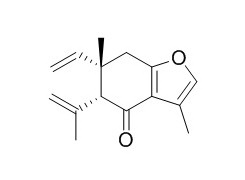Epicurzerenone
Epicurzerenone , germacrone, curdione and curzerenone can be used as chemical markers for discrimination and quality control among different groups of samples.
Inquire / Order:
manager@chemfaces.com
Technical Inquiries:
service@chemfaces.com
Tel:
+86-27-84237783
Fax:
+86-27-84254680
Address:
1 Building, No. 83, CheCheng Rd., Wuhan Economic and Technological Development Zone, Wuhan, Hubei 430056, PRC
Providing storage is as stated on the product vial and the vial is kept tightly sealed, the product can be stored for up to
24 months(2-8C).
Wherever possible, you should prepare and use solutions on the same day. However, if you need to make up stock solutions in advance, we recommend that you store the solution as aliquots in tightly sealed vials at -20C. Generally, these will be useable for up to two weeks. Before use, and prior to opening the vial we recommend that you allow your product to equilibrate to room temperature for at least 1 hour.
Need more advice on solubility, usage and handling? Please email to: service@chemfaces.com
The packaging of the product may have turned upside down during transportation, resulting in the natural compounds adhering to the neck or cap of the vial. take the vial out of its packaging and gently shake to let the compounds fall to the bottom of the vial. for liquid products, centrifuge at 200-500 RPM to gather the liquid at the bottom of the vial. try to avoid loss or contamination during handling.
Research Square2021, 10.21203.
Int J Mol Sci.2019, 21(1):E265
LWT2021, 138:110630.
Polytechnic University of Catalonia2017, 105826
Plant Foods Hum Nutr.2021, 76(4):472-477.
Asian Pac J Cancer Prev. 2020, 21(4):935-941.
J Pharm Biomed Anal.2016, 129:50-59
J Ethnopharmacol.2020, 254:112733.
Curr Top Med Chem.2020, 20(21):1898-1909.
J. of The Korean Society of Food Culture2017, 144-149
Related and Featured Products
Am J Chin Med. 2004;32(2):281-90.
Antimicrobial activity and cytotoxicity of the essential oil of Curcuma zedoaria.[Pubmed:
15315265]
METHODS AND RESULTS:
The chemical compositions of the essential oil of Curcuma zedoaria (Berg.) Rosc. were analyzed by gas chromatography-mass spectrometry (GC-MS) and showed a high content of Epicurzerenone and curdione representing 46.6% and 13.7% of the total oil, respectively. The essential oil was evaluated for potential antimicrobial activity against Staphylococcus aureus, Escherichia coli, Pseudomonasa aeruginosa, Vibrio parahaemolyticus, Salmonella typhimurium and Bacillus cereus. V. parahaemolyticus was sensitive to the presence of the essential oil, while the most resistant strain appeared to be E. coli. Based on 3-(4,5-dimethylthiazol-2-yl)-2, 5-diphenyl-tetrazolium bromide (MTT) assay, nitroblue tetrazolium (NBT) reduction and cell morphology, the essential oil of C. zedoaria could inhibit the proliferation of human promyelocytic leukemia HL-60 cells.
CONCLUSIONS:
These results suggest that the essential oil has the antimicrobial activity against some of Gram- positive and negative pathogenic microorganisms and the components of the extract lead to the apoptosis of human cancer cell line.
Phytochem Anal. 2011 Sep-Oct;22(5):411-8.
Metabolomics study on quality control and discrimination of three curcuma species based on gas chromatograph-mass spectrometry.[Pubmed:
21433157]
Metabonomic analysis is an important molecular phenotyping method for characterising plant ecotypic variations; hence, it may become a powerful tool for quality control and discrimination of traditional Chinese medicine (TCM).
To discriminate and assess the quality of Curcuma phaeocaulis, C. kwangsiensis and C. wenyujin from different ecotypes. The identification of the compositions of essential oils from the three Curcuma species was included in this study.
METHODS AND RESULTS:
Metabolomics analysis was carried out on all samples by gas chromatography-mass spectrometry (GC-MS) coupled with multivariate statistical analysis. Characterisation of phytochemicals in essential oils was performed by automated matching to the MS library and comparison of their mass spectra (NIST05 database).
CONCLUSIONS:
Principal component analysis (PCA) effectively distinguished the samples from different species and ecotypes. Partial least squares discrimination analysis (PLS-DA) was successfully employed in classifying the GC-MS data of authentic, commercial and introduction cultivation samples. Furthermore, the components contributing significantly to the discrimination, namely curzerenone, germacrone, curdione and Epicurzerenone, were screened by PCA and PLS-DA loading plots and further can be used as chemical markers for discrimination and quality control among different groups of samples.



